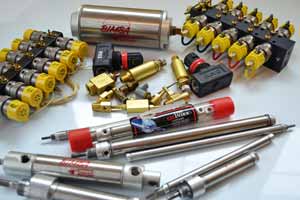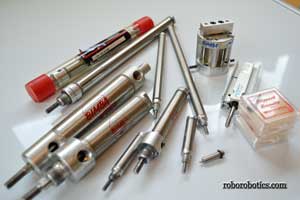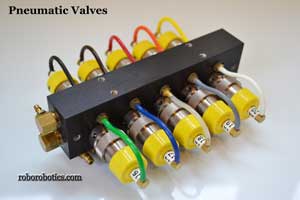Pneumatics in Animatronics
 A majority of professional animatronic figures use pneumatic cylinders for movement. Pneumatic cylinders are chosen for one reason, reliability. A pneumatic system uses compressed air to force a cylinder to move. Air cylinders have been used in manufacturing for a long time. They are very reliable, so replacement is not required frequently. For animatronic figures that operate 12 hours a day, 6 to 7 days a week, owners like the reliability.
A majority of professional animatronic figures use pneumatic cylinders for movement. Pneumatic cylinders are chosen for one reason, reliability. A pneumatic system uses compressed air to force a cylinder to move. Air cylinders have been used in manufacturing for a long time. They are very reliable, so replacement is not required frequently. For animatronic figures that operate 12 hours a day, 6 to 7 days a week, owners like the reliability.
![]()
 Control of pneumatics is a separate issue entirely. Most air cylinders used in animatronics are single-acting or double-acting, sliding rod cylinders. Movement of these cylinders is in one axis (back and forth). The single axis movement is then translated to a range of motion in the figures using cables and other mechanics. A single acting cylinder moves in one direction from the force of the air. When air pressure drops, a single acting cylinder returns to its original position with the help of a spring. A double acting cylinder also moves when air pressure increases on one side of the cylinder. The cylinder, however, does not return to the original position when the air pressure drops. Air pressure is needed on the other side of the cylinder to move the rod back.
Control of pneumatics is a separate issue entirely. Most air cylinders used in animatronics are single-acting or double-acting, sliding rod cylinders. Movement of these cylinders is in one axis (back and forth). The single axis movement is then translated to a range of motion in the figures using cables and other mechanics. A single acting cylinder moves in one direction from the force of the air. When air pressure drops, a single acting cylinder returns to its original position with the help of a spring. A double acting cylinder also moves when air pressure increases on one side of the cylinder. The cylinder, however, does not return to the original position when the air pressure drops. Air pressure is needed on the other side of the cylinder to move the rod back.
In order to control air pressure, air valves are used. There are on-off  (digital) air values and more expensive analog air valves. Analog air valves provide the highest level of control. When used with feedback sensors and a PID control system, analog pneumatic control is very lifelike. Digital valves are much cheaper and with the right plumbing can be set up to mimic analog control. Pressure control valves and check valves are used to provide a slightly higher amount of pressure on one side of a double acting cylinder to allow realistic movement.
(digital) air values and more expensive analog air valves. Analog air valves provide the highest level of control. When used with feedback sensors and a PID control system, analog pneumatic control is very lifelike. Digital valves are much cheaper and with the right plumbing can be set up to mimic analog control. Pressure control valves and check valves are used to provide a slightly higher amount of pressure on one side of a double acting cylinder to allow realistic movement.
